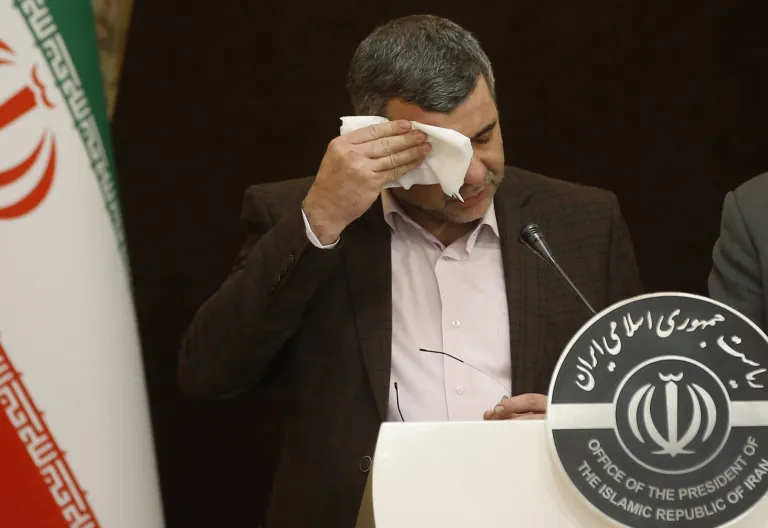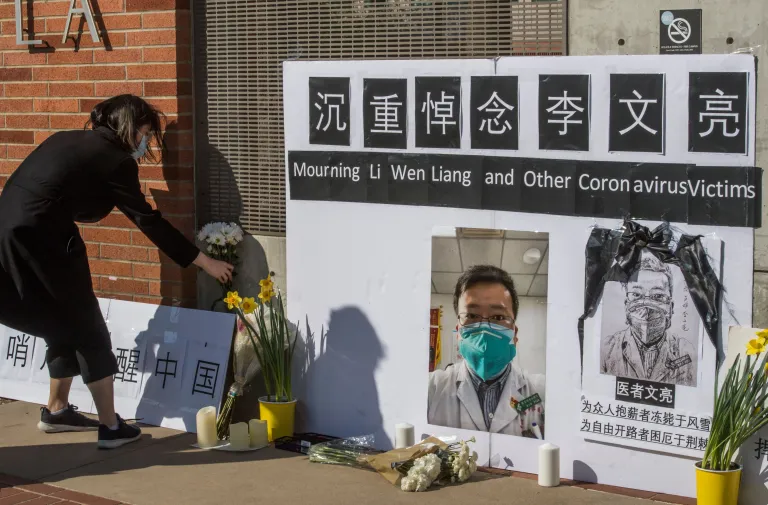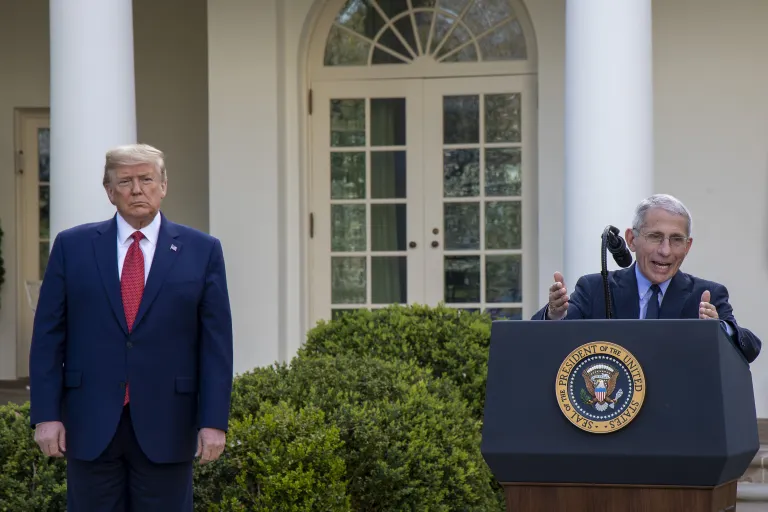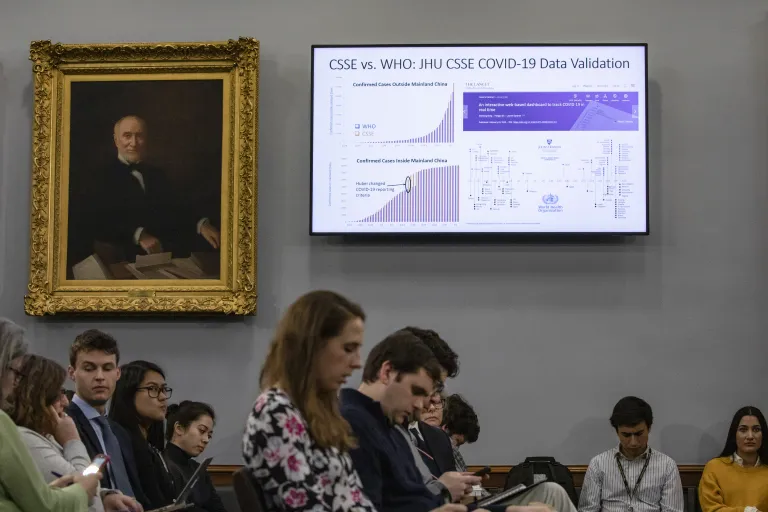- | Feature Feature
- |
Going Viral
How parallel viralities of the coronavirus and information overwhelmed (and changed) the world
The global spread of COVID-19 has followed vectors carved out by information flows far more than epidemiological factors. The contagion has moved at the speed of a vast and restless public, while the bureaucracies of government and science have struggled to keep up. Political efforts to control the story, rather than the disease, allowed the virus to attain pandemic proportions. As is always the case in the age of the rant, scapegoating and finger-pointing have often drowned out technical discussions. Bizarre and probably dangerous remedies have propagated on the web. A babble of panicked voices, contradictory assessments, and institutional warnings have made it difficult to know who speaks with authority on the subject.
In a sense, the trajectory of COVID-19 has been typical of our times: a tsunami of information has overwhelmed the institutions charged with prevention and control. The confusion, this time, touches on matters of life and death. That difference will have a bearing on the future of the institutions involved.
The new strain of coronavirus first appeared in early December in the city of Wuhan, China. The perverse relationship between China’s rulers and information made a wider outbreak inevitable. Certain Western intellectuals, troubled by the chaos of democracy, have recommended Chinese methods of governance as a model for the future. China is thought to have tamed the digital netherworld and turned technology to the cause of stability and progress.
A tsunami of information has overwhelmed the institutions charged with prevention and control.
In truth, the regime is a relic of the last century and a prisoner to obsolete notions of control. Communist Party mandarins still believe that what is known can be subtracted from what is revealed—and, crucially in this case, that what is revealed can be decided from the top. The country is thus a kingdom of lies, in which local officials seek to deceive their provincial masters, provincial officials seek to deceive the national leadership, and national leaders, in turn, hope to deceive the public.
The reflexive reaction by provincial health authorities to the first warning of a new contagious disease was to detain and reprimand the messenger: Dr. Li Wenliang, the doomed hero of the COVID-19 tragedy. As late as December 31, the same authorities were proclaiming that “the disease is preventable and controllable,” and the World Health Organization’s (WHO) office in Beijing accepted the cheerful assessment without question. In mid-January, weeks after the initial outbreak, the city of Wuhan hosted a large-scale Lunar New Year dinner attended by 40,000 families. It is futile to speculate whether the pandemic might have been prevented if the people with power in China had acted responsibly on the information they possessed. In any event, by the time the human toll could no longer be concealed, the virus could no longer be contained.
As I write this, over 81,000 cases of COVID-19 infection have been reported by the Chinese authorities. Around 3,200 of the afflicted are said to have died. Since the regime is a circle of mutual deception, we can assume that the truth is even more appalling. For a ruling class whose legitimacy depends on the perception of ruthless competence, this is a dangerous moment. The usual displays of muscularity—such as building a massive hospital in ten days—have failed to mollify an outraged public. The political and economic consequences, even in the short term, very much bear watching.

Iran followed the same trajectory as China, for the same reasons. Information about the pandemic was treated like a political attack on the regime—something to be angrily refuted rather than swiftly acted upon. The government’s priority was to ensure a large turnout of voters in the February elections that could be promoted as an endorsement of the system. The supreme leader, Ayatollah Ali Khamenei, accused Iran’s enemies of exaggerating the danger of infection to keep voters away. The deputy health minister, Iraj Harirchi, was trotted out to downplay the dimensions of the pandemic, a day before he tested positive for the virus and was quarantined. The widely viewed video of a sickly Harirchi uttering his denials can stand as a parable for the end of dictatorial illusions about information control.
A Triumph of Noise Over Authority
If the public in authoritarian nations was the victim of a fatal silence on the virus, exactly the opposite has transpired in the democratic world. We are drowning in information. We are dazed by the noise.
Shortly before his death, Dr. Li Wenliang pleaded, “there should be more than one voice in a healthy society,” but the uproar of voices surrounding the pandemic has paralyzed many ordinary people trying to decide on the best course of action. On mass media and social media alike, accusations, criticisms, and invidious comparisons—between this country and that one, between present performance and the past—have chased one another at the speed of light. Political commentators have discoursed on the complexities of contagion. Health experts have raged at government decisions. Everyone has had an opinion, a recommendation, a plan, a cure—the Food and Drug Administration found it necessary to insist that drinking bleach would not protect against infection and might, in fact, kill the drinker.
Americans paid scant attention to the story until January 21, when the first case was reported in the United States. Since that wake-up call, the two overlapping viralities—the actual spread of COVID-19 and our ceaseless chatter about the disease—have competed for our attention. Increasingly, the latter has obscured the former. By early February, the WHO complained of a “massive infodemic” running parallel to the pandemic that “makes it hard for people to find trustworthy sources and reliable guidance when they need it.” The warning did little more than state the obvious about our post-truth information sphere.

Panic, posturing, conspiracy theories, and malicious lies have flooded the usual online pathways. China was said to have cooked up COVID-19 in a secret biological warfare laboratory—an accusation soon turned against the CIA. Even Bill Gates, founder of Microsoft, received an honorary mention as the cause of the disease—but then, so did the Rothschilds. On the one hand, matters were proclaimed to be far worse than the authorities dared to reveal. Exaggerating the death toll, particularly in China, became a competitive sport. On the other hand, cures were believed to be at hand, though held back for obscure reasons. A Facebook post maintained that a vaccine against the virus already existed. Needless to say, it went wildly viral.
For once, the large digital platforms behaved responsibly. Mark Zuckerberg offered the WHO free space on Facebook. Google and Microsoft gave away advanced streaming tools to connect those working from home. Amazon prioritized deliveries of food and medical supplies. Facebook, Instagram, YouTube, and Twitter labored to “remove content with false claims or conspiracy theories that have been flagged by global health organizations.” Searches for “coronavirus” were routed to reputable health organizations like the WHO or the Centers for Disease Control and Prevention (CDC), and to mainstream news media reports.
Such well-intentioned efforts did nothing to abate the uproar. The tsunami of digital information was too vast and moved too fast for tactical interventions. As we should have learned from the “fake news” controversy of 2016, the line between fact, perspective, opinion, and manipulative falsehood is less clear than we might imagine—and there are no trusted gatekeepers to make the call. That is at the heart of our predicament.
When the COVID-19 story hit, the information sphere already suffered from a pre-existing condition: a hemorrhage in the legitimacy of the big institutions. In every field, the authorities lacked credibility. Facebook and Twitter could bend the knee before WHO or the CDC or the New York Times, but the public remained angry and mistrustful. The power to explain persuasively has fractured, and the account of the pandemic was always destined to be a ragged babble of voices.
Tweeting in the Time of Coronavirus
The public expected the institutions to fail, and in the present emergency many believe their worst expectations have been met. Scorn has been heaped on the WHO for its submissive posture with regard to China. The CDC became a target of outrage after an abject and prolonged failure to produce adequate supplies of the COVID-19 test kit. The Food and Drug Administration (FDA) has received its share of condemnation for appearing to be mesmerized by proceduralism and uninterested in delivering a cure.
Much of the criticism has been justified. In the rolling chaos of the crisis, global and national health institutions have not covered themselves with glory. The public might reasonably expect that something called “Centers for Disease Control” should actually control the spread of the disease. It did no such thing. Yet the CDC isn’t just a name; it’s a ponderous hierarchy of 15,000 people, hedged by strictures and regulations that made perfect sense under normal conditions. Like all bureaucracies, it lacked a panic button. Similarly, the WHO is a transnational organization that can exist only by kowtowing to powerful but propaganda-prone dictatorships.
This was nothing like the willful deception and moral vacuum of Wuhan, however. This was a structural inadequacy to process information at the relentless pace of the contagion—which is to say, of a highly mobile public. In China, COVID-19 might have been reduced to a minimum of lost lives. Once the virus leaped that initial barrier, an enormous number of variables were added to the equation. The health bureaucracies of the democratic world should have performed more competently, but the improvement, except for a few outliers, would have occurred on the random margins of the outbreak.
The country needed a voice for calm and responsibility in the storm. Instead, it got Donald Trump
Of our political institutions and leadership, the less said the better. The country needed a voice for calm and responsibility in the storm. Instead, it got Donald Trump. For three years, the president had cast an immense shadow over the information landscape. He has dealt with crises and controversies simply by absorbing them, making them all about his larger-than-life, love-me-or-loathe-me personality. This he could not do with COVID-19. In the existential moment of a worldwide pandemic, disputes about Trump’s performance have occupied a limited space in the public’s attention. The story this time was never going to be about him, and the president seemed baffled regarding the part he was expected to play.

His tweets followed an arc from truculence to eventual comprehension. Deep into February and early March, Trump downplayed the danger from the virus, comparing it favorably with the death toll from flu season, when “Nothing is shut down, life & the economy go on.” “Market starting to look very good to me!” he tweeted, even as the Dow Jones suffered near-record losses. Inevitably, the enemies to be blamed for sowing panic were the “fake news” media and his Democratic Party opponents. And on the subject of COVID-19, the connection between presidential tweets and medical reality has been, on occasion, tenuous.
But Trump is nothing if not attuned to his audience, and around mid-March, the script on social media flipped. While he could not resist an occasional boast or a gratuitous troll, the Twitter stream of this most personalistic of politicians turned largely institutional in content. The president began to call for national unity and to praise various groups in civil society and government for their efforts during the outbreak. His retweets drew attention to the details of virus-related legislation. He began to retweet the words of others—senators, health authorities, even journalists—more than he tweeted his own.
Like a significant slice of the world’s population, President Trump has adapted his behavior to extraordinary circumstances. Populist disruption has given way to establishment theater: a daily televised press conference on the outbreak has become the preferred mode of presidential communication. Ratings have been astoundingly high. At the moment, Trump ranks with those leaders—Emmanuel Macron of France, for one—who have received a measure of public approval for their handling of the crisis.
That does nothing to alter the reality of the situation. With very few exceptions, governments have been helpless to prevent the spread of the infection and slow to respond to its effects. The hemorrhage of authority has advanced in tandem with the pandemic. Donald Trump, a creature of the sickness of the institutions, was not built for reassurance: in his new conventional posture, he sometimes has resembled an arsonist condemned by a strange fate to impersonate a firefighter.
An Extinction Event of the Institutions
The enormity of the COVID-19 story in the eyes of the public has cast every other aspect of human life into the dark. On March 12, the U.S. military launched an air strike against pro-Iranian militias in Iraq—part of a policy of violent retaliation that, not long ago, had generated much controversy. The attack went mostly unnoticed. On March 16, Russia’s highest court opened the way for Vladimir Putin to remain president until 2036. Outside the battered Russian opposition, few paid attention to this remarkable power grab. Events in the world have not been frozen in place by the pandemic. Yet the information sphere has left no space for anything else.
Agenda-setting theory holds that an event will appear significant to the degree that it dominates public discussion. The unprecedented informational disproportion between COVID-19 and all else has made the disease feel like an equally unprecedented catastrophe. Digital and media noise, as much as any scientific projections, helped stampede the markets and drove elected officials to measures that really were without precedent. Liberal democratic governors, who only a few months before had criticized President Trump’s tough stance on immigration, have now closed the borders of their states and locked down citizens in their homes. Whether this was prudent anticipation that would result in saved lives or a panicked response to the uproar may not be known until the tempest is over—and possibly not even then.
Despite the astronomical levels of information, very little is known with certainty.
The same holds true for the entire episode. Despite the astronomical levels of information, very little is known with certainty. Trillions of dollars evaporated from the financial markets while much of the global economy stood immobilized. Does the potential toll from the virus justify the cost to impoverished households? Only an inaudible minority appeared interested in reckoning such trade-offs.
Meanwhile, the great health organizations have been improvising every step of the way. Before condemning the “infodemic,” the WHO contributed to it by tweeting that “no clear evidence of human-to-human transmission” of the virus had been found “by the Chinese authorities.” The properties of potential antiviral drugs like chloroquine have become a topic of constant wrangling among global experts. A survey of infectious disease researchers has delivered vastly disparate estimates of mortality in the United States: anywhere between 4,000 and 1 million.
Governments at every level have also stumbled forward one decision at a time. The surest sign of uncertainty has been the lack of a framework back to normalcy. Presidents, ministers, bureaucrats—none can see past the noise.

Information is the thin patchwork of what we know, or think we know, spread over the infinite complexity of the world. Often, it’s not enough. Under conditions of insufficient knowledge, central planning becomes less useful than local adaptation. Trial and error conducted from the bottom up should inform decisions made at the top. From the onset of the crisis, pockets of civil society have led the way to an appropriate response.
With the CDC and FDA tied up in bureaucratic knots, doctors at the University of Washington developed their own COVID-19 test kits, and the Gates Foundation offered home test kits to the public. Elon Musk, the CEO of Tesla, donated 1,000 ventilators needed by California hospitals. Preprint servers for scientific studies began to release “a torrent of data” on the pandemic, forcing the institutional peer-reviewed journals to improve on their speed of publication. The national governments most successful in managing the outbreak, like that of Taiwan, have worked in fruitful partnership with the private sector.
Amid the lockdowns and other desperate measures, it is possible to discern the venerable structures that govern our world tearing apart at the seams—and something strange and new moving into their place. The crisis of authority has been thrown into fast forward: the new coronavirus, like the meteor that killed off the dinosaurs, appears to have smashed open a space for faster, nimbler institutional forms, better adapted to the movement of information in the digital age.
But that is still guesswork. To learn what will emerge on the far side of the crisis, we will have to wait however long it takes before the noise subsides.
Title photo by Kevin Frayer/Getty Images